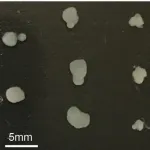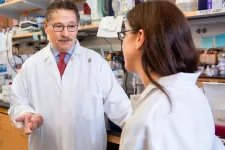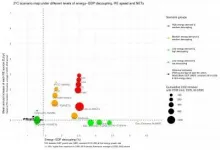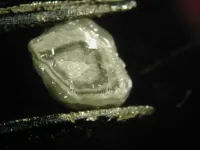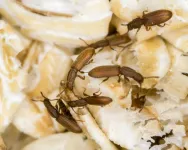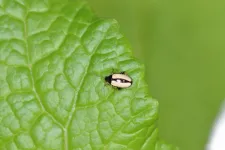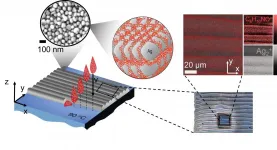(Press-News.org) Like many around the world, the lab of Professor Mriganka Sur in The Picower Institute for Learning and Memory at MIT has embraced the young technology of cerebral organoids, or "minibrains," for studying human brain development in health and disease. By making a surprising finding about a common practice in the process of growing the complex tissue cultures, the lab has produced both new guidance that can make the technology better, and also new insight into the important roles a prevalent enzyme takes in natural brain development.
To make organoids, scientists take skin cells from a donor, induce them to become stem cells and then culture those in a bioreactor, guiding their development with the addition of growth factors and other chemicals. Over the course of weeks, the stem cells become progenitor cells that multiply and then go on to become, or "differentiate" into, neurons or other brain cell types. Along the way the cells also migrate within the growing blob to take their places forming basic brain structures and circuits.
A beauty of organoids, therefore, is that as the cells in the culture grow and develop together, they simulate many of the basic processes that occur when real brains take shape. When cell donors have genes that cause disease, the organoid grown from their cells will reproduce underlying disease characteristics. The Sur lab uses organoids to study the abnormal brain development in Rett Syndrome, a devastating autism-like condition with a genetic underpinning.
A common practice among labs growing organoids is to improve the viability of the cells by adding a small molecule chemical called CHIR 99021 to inhibit the activity of a ubiquitous natural enzyme called GSK3-beta. In the new study in PLOS ONE the team led by Picower Fellow Chloé Delépine, confirmed that while different doses of CHIR 99021 can indeed keep cells alive, they have opposite effects on organoid growth - low doses promote growth but high doses constrain it and very high doses will stop it altogether. That information alone has obvious implications for labs using varying doses of CHIR 99021, but because Delépine's team investigated how these growth effects occur, it also helps to clarify what GSK3-beta activity affects during brain development.
It's an important question. Other research groups, for instance, have shown that perturbations in a signaling pathway involving GSK3-beta in the brain are associated with schizophrenia and autism. The new findings model how varying levels of inhibition may affect development.
"It's is not just increasing the viability of the cells, it is also changing other cellular processes such as division, differentiation and migration," Delépine said. "Our idea was to test the effects of different doses and to better understand these mechanisms we observed."
Eight organoids are shown in three columns. They appear as irregularly shaped white blobs. A scale marker suggests they are about 3mm in width.
Organoids showed different degrees of growth based on the dose of CHIR 99021. Controls are on the left. The ones in the middle received a low dose. The ones on the right received a high dose.
Different doses, opposite effects
To conduct the study, Delépine's team cultured organoids and, from day 15 through 35 of their development, treated them with doses of either an inert control, or 1, 10 or 50 micromolar of CHIR 99021. They then tracked various properties of cells by staining for different molecular markers of those properties.
Straight away, she noticed major differences in organoid size depending on the dose received. Low dose (1 micromolar) organoids were 1.6 times bigger than controls, but high dose (10 micromolar) organoids were 1.8 times smaller and very high dose (50 micromolar) organoids simply stopped growing at all early into treatment.
The growth differences were not because of cell death. As expected given that labs use CHIR 99021 to improve cell survival, adding CHIR 99021 enhanced cell viability and the effect was stronger for high dose than low dose treatments. But when the lab stained for markers of proliferation, or cell division, they found that high-dose organoids exhibited less while low-dose organoids exhibited more than controls.
When the team looked at another cellular activity that could affect growth they found a similar pattern. In high-dose organoids fewer cells differentiated into neural progenitor cells needed to produce new neurons while in low-dose organoids proliferation increased. As a result, high-dose organoids had fewer neurons.
Additionally, the low dose of CHIR 99021 resulted in more migration of newborn neurons to places needed for structural development of the organoid than control treatment did, suggesting that slight inhibition of GSK3 beta contributes to increased migration.
Delépine noted that the growth-promoting effects of low doses or the growth-limiting effects of high doses are not "good" or "bad." They are just levels of control of the culture. The new study provides more insight into how to use CHIR 99021 to achieve the desired end.
"It really depends on the goal of the organoid research that you are doing," she said. "Depending on what you want, different doses of this molecule can help you achieve a different phenotype."
And in natural brains, the study suggests, GSK3-beta likely plays a key role in the proliferation of progenitor cells, their differentiation into mature brain cells, and the propensity of those cells to migrate.
In addition to Delépine and Sur, the paper's other authors are Vincent Pham and Hayley Tsang.
The National Institutes of Health, The Simons Foundation Autism Research Initiative and the JPB Foundation supported the research.
INFORMATION:
COLUMBUS, Ohio - People are more persuaded by the actual messages contained in social media posts than they are by how many others viewed the posts, a new study suggests.
Researchers found that when people watched YouTube videos either for or against e-cigarette use, their level of persuasion wasn't directly affected by whether the video said it was viewed by more than a million people versus by fewer than 20.
What mattered for persuasion was viewers' perception of the message as truthful and believable.
"There wasn't a bandwagon effect in which people were persuaded by a video just because ...
An international team of researchers at Great Ormond Street Hospital (GOSH), and University of California, Los Angeles (UCLA) have developed a gene therapy that successfully treated 48 out of 50 children with a form of severe combined immunodeficiency that leaves them without an immune system.
Severe combined immunodeficiency due to adenosine deaminase deficiency, also known as ADA-SCID, is a rare, life-threatening disease that prevents children from living a normal life. It is caused by mutations in the gene that creates the enzyme adenosine deaminase, which is essential to a functioning immune system.
Children with ADA-SCID have no immune system and, if left untreated, the condition can be fatal within the first two years of life. Day-to-day activities ...
An experimental form of gene therapy developed by a team of researchers from UCLA and Great Ormond Street Hospital in London has successfully treated 48 of 50 children born with a rare and deadly inherited disorder that leaves them without an immune system.
Severe combined immunodeficiency due to adenosine deaminase deficiency, or ADA-SCID, is caused by mutations in the ADA gene that creates the enzyme adenosine deaminase, which is essential to a functioning immune system. For children with the condition, even day-to-day activities like going to school or playing with friends can lead to dangerous, life-threatening infections. If untreated, ADA-SCID can be fatal within the first two years of life.
The investigational gene therapy method involves first collecting ...
CAMBRIDGE, MA -- In early 2020, a few months after the Covid-19 pandemic began, scientists were able to sequence the full genome of the virus that causes the infection, SARS-CoV-2. While many of its genes were already known at that point, the full complement of protein-coding genes was unresolved.
Now, after performing an extensive comparative genomics study, MIT researchers have generated what they describe as the most accurate and complete gene annotation of the SARS-CoV-2 genome. In their study, which appears today in Nature Communications, they confirmed ...
A receptor that helps conserve energy when food is scarce may be the key to a safer approach to treating diet-induced obesity, research led by the Garvan Institute of Medical Research has revealed.
In a study using experimental models and fat tissue biopsies from obese individuals, the team revealed that blocking a specific receptor of the molecule neuropeptide Y (NPY), which helps our body regulate its heat production, could increase fat metabolism and prevent weight gain.
"The Y1 receptor acts as a 'brake' for heat generation in the body. In our study, we found that blocking this receptor in fat tissues transformed the 'energy-storing' fat into 'energy-burning' fat, which ...
The first comprehensive comparison of 'degrowth' scenarios with established pathways to limit climate change highlights the risk of over-reliance on carbon dioxide removal, renewable energy and energy efficiency to support continued global growth - which is assumed in established global climate modelling.
Degrowth focuses on the global North and is defined as an equitable, democratic reduction in energy and material use while maintaining wellbeing. A decline in GDP is accepted as a likely outcome of this transition.
The new modelling by the University of Sydney and ETH Zürich includes high growth/technological change and scenarios summarised ...
Diamonds are sometimes described as messengers from the deep earth; scientists study them closely for insights into the otherwise inaccessible depths from which they come. But the messages are often hard to read. Now, a team has come up with a way to solve two longstanding puzzles: the ages of individual fluid-bearing diamonds, and the chemistry of their parent material. The research has allowed them to sketch out geologic events going back more than a billion years--a potential breakthrough not only in the study of diamonds, but of planetary evolution.
Gem-quality diamonds are nearly pure lattices of carbon. This elemental purity ...
Saw-toothed grain beetles live in a symbiotic association with bacteria. Their bacterial partners provide important building blocks for the formation of the insect's exoskeleton, which protects the beetles from their enemies as well as from desiccation. In a new study, a team of scientists from the Johannes Gutenberg University in Mainz, the Max Planck Institute for Chemical Ecology in Jena, and the National Institute of Advanced Industrial Science and Technology in Japan demonstrates that glyphosate inhibits the symbiotic bacteria of the grain beetle. Beetles exposed to the weedkiller no longer receive the building blocks they need from the bacteria. The study shows that glyphosate has the potential to harm insects indirectly by targeting their bacterial partners ...
When horseradish flea beetles feed on their host plants, they take up not only nutrients but also mustard oil glucosides, the characteristic defense compounds of horseradish and other brassicaceous plants. Using these mustard oil glucosides, the beetles turn themselves into a "mustard oil bomb" and so deter predators. A team of researchers from the Max Planck Institute for Chemical Ecology in Jena, Germany, has now been able to demonstrate how the beetle regulates the accumulation of mustard oil glucosides in its body. The beetles have special transporters in the excretory system that prevent the excretion of mustard ...
Inks containing metal nanoparticles are among the most commonly-used conductive materials for printed electronics. Ink-jetting layers of MNP materials allows for unpreceded design flexibility, rapid processing and 3D printing of functional electronic devices such as sensors, solar panels, LED displays, transistors and smart textiles.
Inkjet 3D printing of metals typically form a solid printed object via a two-step process: solvent evaporation upon printing (pinning) and subsequent low-temperature consolidation of nanoparticles (sintering). The low temperature is important as in many applications the nanoparticles are co-printed with ...
